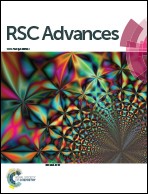Influence of hyperbranched copper phthalocyanine grafted carbon nanotubes on the dielectric and rheological properties of polyarylene ether nitriles
Abstract
Novel hyperbranched copper phthalocyanine covalently grafted carbon nanotube/polyarylene ether nitrile (HBCuPc-CNT/PAEN) flexile composite films were prepared via solution casting. The CNTs are enwrapped by a functional intermediate HBCuPc thin layer which forms a rough shell on the surface of the CNTs to ensure a good dispersion of CNTs in the PAEN matrix. The dielectric layer (HBCuPc-CNTs) is intercalated by insulating layers (pure PAEN, acting as the isolating layer). Due to the high capacitance of the dielectric layer and the effective blocking of the mobility of free charge carriers by the insulating layers, the polymer-based composite films exhibit not only a high permittivity but also an extremely low dielectric loss and excellent breakdown strength. SEM images show that HBCuPc-CNTs are perfectly embedded in the matrix and no pull-out phenomenon can be observed. In addition, the rheological properties of the resulting composite films also indicate that the grafted CNTs present a good dispersion and strong interactions with the PAEN resin, thus resulting in a significant improvement of the mechanical and thermal properties of the PAEN composite films.


 Please wait while we load your content...
Please wait while we load your content...